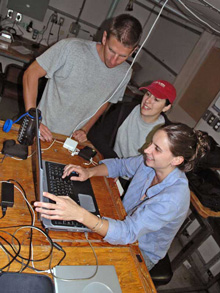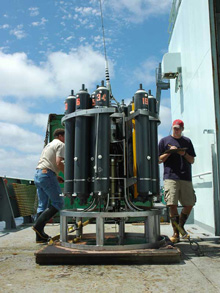
The CTD/Niskin rosette cast arrives back on deck full of water samples. Each Niskin bottle on the rosette is remotely triggered to collect water samples at various depths. Water collected from a hydrothermal vent plume are sampled back on board to determine the type of hydrothermal vent the plume came from. Click image for larger view and image credit.
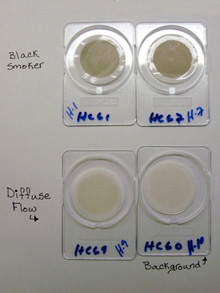
Filter samples from the CTD/Niskin showing "black smokers" and normal seawater. Click image for larger view, complete caption and image credit.
A Birthday Surprise
December 13, 2005
Kelley Elliott
Web Coordinator
After 8 days under tow, the longest the DSL120 has ever made, the vehicle is finally back on deck at 3:30am having completed an extensive survey of the ridge crest along the GSC. The phase bathymetry collected by the DSL120 looks great, and both the Chief Scientist and Co-PI, Scott White, are pleased with the quality of the data.
The CTD/Niskin Rosette cast is deployed at 8:42 am and towed along the axis where “black smokers” were previously detected. Sensors indicate the presence of a plume during the initial along-axis tow, however the vent plume type is still uncertain. At 6:21pm, the CTD/Niskin Rosette arrives on board, full of water samples collected at various depths. The plume team extracts water samples from labeled Niskin bottles and takes them into the lab for analysis. Success! Filter analysis of the water samples confirms the presence of black smoker plumesThe Medea camera sled is deployed next. Sinking towards the bottom at 35 meters/minute, she reaches the seafloor at 10:11pm at a depth of 1663 meters. Data showing the depth from the surface is feeding in fine, but the monitor displays a problem: the altimeter sensing the camera sled’s height off the bottom is incorrect, showing “??” for altitude. Without knowing the Medea’s altitude, flying her is dangerous, as pilots risk running into elevated seafloor features and damaging the camera sled. Technicians and researchers try to communicate with Medea via a live serial link on the surface, attempting to reconfigure the altimeter, but receive no response. After about 40 minutes trying to communicate with the vehicle and fix the problem from the surface, the decision is made to bring Medea back on deck for repairs. She sets down on deck at 11:30pm, and DSL technicians replace the malfunctioning altimeter with one that works from the DSL120’s clump weight. The entire process takes 23 minutes, and by 11:53pm the Medea’s altimeter is repaired, and she descends deep down to the ocean floor.
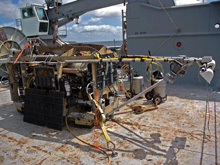
After an initial deployment to the seafloor, the Medea is brought back on deck to replace a malfunctioning altimeter. Without knowing the Medea's altitude, flying her is dangerous, as pilots risk running into elevated seafloor features and damaging the camera sled. The DSL team conducted the replacement quickly and efficiently, putting the Medea back in the water a mere 23 minutes after she is brought on deck for repairs. Click image for larger view and image credit.
Medea reaches the bottom and scientists and technicians become accustomed to maneuvering the camera sled while characterizing the lava flows of the seafloor by shape and age. Pillow and lobate fields unfold beneath the camera sled, followed by a wide fissure (a crack in the seafloor). Sensors detect anomalies in the Eh (Redox potential) of surrounding seawater and at 5:19 am excitement fills the room: smoke envelops the screen and observers crowding around need only wait 15 minutes until their first black smoker vent comes into sight. Excitement explodes in the DSL van, and Chief Scientist, Rachel Haymon, dances the new “hydrothermal vent” dance, characteristic of the jig. Visual confirmation and precise location of black smokers on the Galapagos Spreading Center is made for the first time.
The Medea continues on to explore a large vent field, and biota appears sparse as live feed pours in from the Medea’s video cameras. The only vent biologist on board, Taylor Heyl, cannot hide an increasingly disappointed face as at vent after vent, few forms of life appear on the monitors inside the van. No definite confirmation of chemosynthetic mussels or clams is made before Medea departs the bottom at 9:30 am, and the ship prepares to steam back to port to pick up additional scientists. People trickle slowly out of the van, Taylor being one of the last: it was her 26th birthday, and all she wanted was to see chemosynthetic clams. She walks back to the bio lab, finishes up a bit of work, and heads to the mess deck for lunch. Shortly after, DSL Technician Cindy Sellers walks in the bio lab with a CD in hand. “Where is Taylor?” she asks me as I work on this log. “Just missed her, she headed up to lunch,” I respond. “Well this CD of images is for her,” she tells me as she sets down the high resolution images taken by the still camera on board the Medea camera sled.
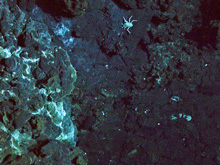
Still image taken by the Medea camera sled showing vent organisms on the seafloor. The images taken by the still camera on the photo sled are much higher resolution than the video feed, enabling scientists on board to see smaller features in greater detail, such as the galatheid crab (also called "squat lobster") and mussel shells thought to be seen in this image. Click image for larger view and image credit.
After lunch, Taylor returns to the bio lab to continue work. I sit at a large wooden desk in the middle of the lab shared by 3 people and entirely too much equipment; Taylor sits to my right. She picks up the CD resting next to her widescreen HP laptop and inserts it into the computer. Less than a minute later, excitement paints her face. The images taken by the still camera on the photo sled are much higher resolution than video feed, and the detail that can be seen in them is amazing. Taylor is not only able to see more clearly, she is able to zoom in on features that catch her eye. “We have mussels,” she exclaims excitedly, and a minute later, “a clamshell, I love clams! It looks like this is the site of a former mussel bed!” I realize I have not yet told her happy birthday today- a bad position for a roommate to be in. I turn to Taylor after she sees her first clam, “By the way, Happy Birthday Taylor!” A big grin crosses her face as she continues to gaze intently on the vent field images.
Fast FactDid you know that black smoker vents can be four times as hot as the water that boils in your teakettle?
Sign up for the Ocean Explorer E-mail Update List.





























